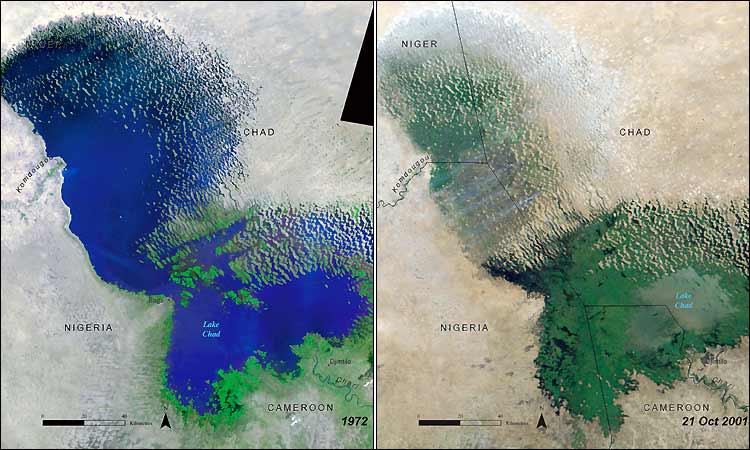Our planet is awash in water, more than 300 million cubic miles of it. About 97.5% of it is difficult or impossible to use, however, because it’s salt water. Of the 2.5% or so that’s left, about 2/3 of it is locked in glaciers. This page is about what’s actually accessible (roughly .01% of the total) and how we can all have enough of it to survive.
Global water use has roughly tripled since 1950, during the same period of time in which the world’s population has doubled. So at least in the past, world water use per capita has continued to increase. This is likely to change. Declining water supplies will force the adoption of water conserving practices even among affluent societies.
So our water use per person may level off or even decline. Yet the world’s inhabitants will continue to consume more fresh water simply because there will be more humans on the planet. In what ways will this increased water use be visible?
 First, we will continue to exhaust our lakes and rivers. As in so many other areas, Africa provides the most ready example.
First, we will continue to exhaust our lakes and rivers. As in so many other areas, Africa provides the most ready example.
Consider Lake Chad, a shallow inland sea bordering on four nations in Africa, Chad, Niger, Nigeria, and Cameroon. At one time it covered 15,000 square miles and provided fish, drinking water, and vital transportation for millions living in central Africa. Now, after massive irrigation projects and simply too many people using it, it has shrunk to a shadow of its former size, approximately 500 square miles. The photo compares the lake’s size in the mid 1980s with its size today.
Perhaps more tellingly, when you use Google Earth to get truly close to Lake Chad, you see that even the portion that appears to be lake in the photo is in reality swampland, choked by algae and other plants.
And lest we think this is something that happens only in Africa, lakes are disappearing also in Europe, Asia, South America, Australia, and North America. The climate of many parts of southern Europe is becoming more like that of Saharan Africa, driven by catastrophic climate change, by the growing of crops that demand too much irrigation water, like lettuce, and relentless waves of housing development, with accompanying water-hungry casinos and golf courses.
Nearly everyone living in Los Angeles knows the sordid and unhappy history of Owens Lake in eastern California. Having held water for hundreds of thousands of years, Owens Lake gave up all its water to Los Angeles from 1913 to 1926 and became a dry lakebed. Now the lakebed, referred to in geography as “Owens (Dry) Lake,” is thought to be the largest single contributor to small particle contamination in the U.S. Again, the picture on Google Earth tells it all if the image is the same one we saw there. Ask for Keeler, California. If you can find it below that massive cloud of airborne dust, you can look to the east and north and find what remains of “Owens (Dry) Lake.”
Could this ever affect the Great Lakes in the U.S.? Well, yes.
The Great Lakes basin holds 20% of the accessible fresh water of the world. It’s not hard to envision a time when drought associated with catastrophic climate change might join forces with over-irrigation and overpopulation to cause one or more of the Great Lakes to shrink dramatically. That’s what happens when you keep adding more and more people who need water.